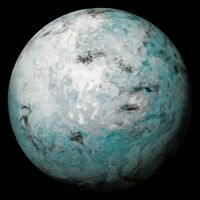Tsanfau II
 | |
| Discovery | |
|---|---|
| Discovered by | Allister Llloyd |
| Discovery date | 15 November 1799 at the
Vannese Royal Observatory, Castle Borough, |
| Designations | |
| MPC designation | Tsanfau II |
| Orbital characteristics | |
| Satellite of | Tsanfau |
| Physical characteristics | |
Mean radius | 344/5 km |
| Mass | 1.911E+20 |
Mean density | 1.116 g/cm^3 |
| 0.107 m/s^2 | |
| 272.1 m/s | |
| Atmosphere | |
| Composition by volume | 78% methane (CH4), 5% ammonia (NH3), 5% water (H20) 5% ammonium hydrosulfide (NH4SH) 5% methane hydrate, 2% trace other gases |
Tsanfau II is the second-largest moon of Tsanfau. It is about 690 kilometers (428 mi) in diameter. Tsanfau II is mostly covered by freshly created and relatively clean ice sheets, exposed rocky mountaintops, old craters, ice scraps, ice geysers, water-ice layers, and a surprisingly dense atmosphere for its size.
Tsanfau II was discovered on November 15, 1799, by astronomer Allister Llyod, but little was known about the moon until much later. Flybys by space probes revealed its surface, atmosphere, and environment in greater detail. The most surprising of discoveries being the relatively dense atmosphere and ice geysers that produced jets of materials and chemicals. These ice geysers are leading contender into why Tsanfau II has such a dense atmosphere for its size and proximity to Tsanfau. The planet itself is constantly tugging on Tsanfau II's atmosphere, which may be a factor in Tsanfau II's weather patterns. Tsanfau II is also currently geologically active and may have a subsurface ocean.
History
Discovery
Tsanfau II was discovered by astronomer, composer, and mathematician Allister Llloyd on November 15th, 1799 using a 1.5 m (59 inch) 42-foot telescope at the Vannese Royal Observatory in modern-day Castle Borough, The Vanna. Tsanfau II was Llloyd's only major discovery, with the rest being smaller minor objects including one comet. Lloyd's recounts of the discovery have ranged from being an accident to a calculated mathematical search, with the very first account of Tsanfau II being recorded in Lloyd's index as "1799; November 15 -> T-Object Two?, will verify." providing no extra details as to which account is true.
Naming
Geological features on Tsanfau II are named by Anteria International Science Commission. Ice lines and scrapes are named after Lloyd's musical compositions.
Observational History

